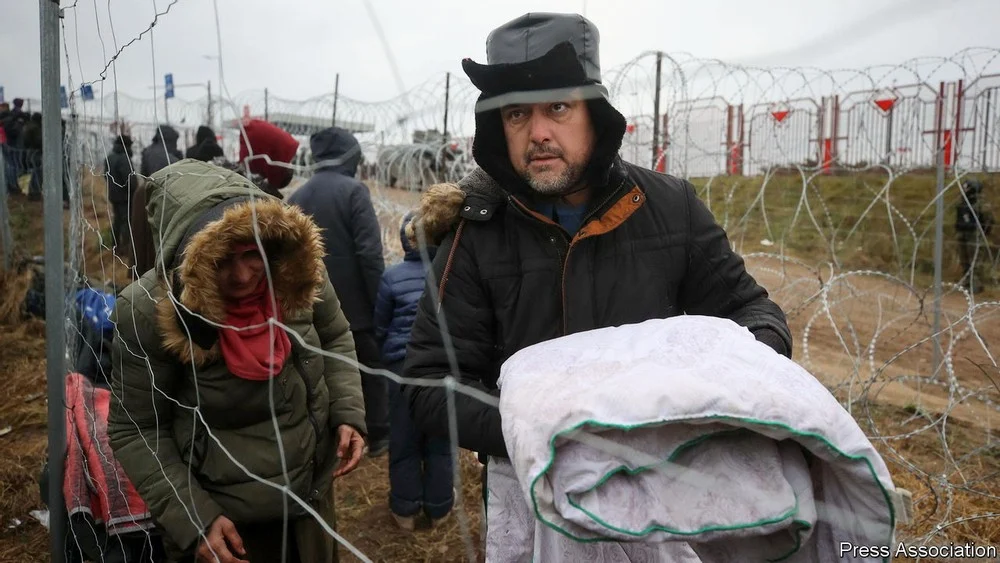ALL IS DISQUIET on the Eastern front. On the border between Poland and Belarus, refugees from the Middle East are massing. They have been lured there by Alexander Lukashenko, the Kremlin-backed dictator of Belarus, with false promises of a new life in the West. On the Russian side of the Ukrainian border, it is soldiers that are gathering, in sufficient numbers to raise concern in America. And inside Russia, repression is growing. The latest victim is Memorial, Russia’s most venerated human-rights organisation, set up in 1987 to document the crimes of the Soviet regime. It is now being threatened with closure.
Ominous Russian troop manoeuvres have taken place before. But this time America is warning its European allies that it considers an invasion a genuine possibility. Although much is still unclear about Russia’s troop movements, many units on their way home from Belarus, which played host to Russia’s quadrennial Zapad exercise in September, have set up camp near the Russian town of Yelnya, around 200km (125 miles) from Ukraine’s border.
Russia alarmed Ukraine with a similar build-up in April, before pulling many of the troops back. Then, the open movement of troops, during the day and in large groups, at least offered analysts some reason for calm. This time operations have been more covert. America is so worried that earlier this month the head of the CIA, William Burns, flew to Moscow to dissuade Vladimir Putin, Russia’s president, from invading. It is unlikely that America would dispatch its top spy without good reason. But it is equally unlikely that Mr Putin is simply going to back off, without testing the resolve of Joe Biden, his American counterpart. So a protracted period of heightened tension may be on the cards.
Nobody knows whether the troops are intended for action in Ukraine or Belarus, or simply for the intimidation of both—probably the most likely explanation. According to a European intelligence source, the Russian force is smaller than it was earlier in the year and therefore would struggle to take and hold much Ukrainian territory, although Volodymyr Zelensky, Ukraine’s president, estimates that it numbers 100,000 troops.
Michael Kofman, who watches Russia at CNA, an American think-tank, wrote recently on Twitter, “It does appear that the Russian military has been ordered to position itself for a possible operation in the coming months.” But this does not mean that any offensive is imminent, or that the final go-ahead has been given, he noted. Russia’s priority for months has been securing German regulators’ approval for Nord Stream 2, a gas pipeline that bypasses Ukraine, says Dmitri Trenin of Carnegie Moscow, a think-tank. An invasion would surely scupper that.
For now, at least, Russia’s goal of undermining Ukraine and plunging it into crisis may be better achieved by other means, such as disrupting its energy supplies. This month Russia halted coal exports there, exacerbating local fuel shortages. Some worry that Russia might curb gas shipments as well. “It’s a very disturbing trend,” says Yuriy Vitrenko, the head of Naftogaz, the state gas company.
Blackouts and heating outages could spark strikes and protests, Russia doubtless hopes, undermining Mr Zelensky. Dmitry Medvedev, a former prime minister and a member of Russia’s security council, recently published an article calling Ukraine’s leadership “imbecilic”. There is no point in talking to Mr Zelensky, he argued, since he is merely a Western puppet. “Contacts with such weak leaders are counterproductive; any moment they can trade you 15 kopecks.”
Similar moves are afoot further north. Russia has been pushing Mr Lukashenko to surrender what is left of Belarusian sovereignty, and is already using him to destabilise the EU. Mr Lukashenko’s cynical use of innocent and desperate people as a weapon against the bloc is being given the backing of the Kremlin’s propaganda machine. Behind the migrants stand Belarusian soldiers, pushing them towards the border fence and giving them the tools they need to breach it. With 15,000 Polish troops (and a small group of British soldiers on the way) on the other side the risk of an accident is rising. On November 11th Russia sent two TU-160 bombers flying over Belarus, just 60km from the Polish border.
Temperatures fall below zero at night and people are sleeping in uninsulated tents. Russia and Belarus hope to generate a humanitarian crisis that will test the EU’s resolve and unity. So far, the EU has stood firm, backing Poland in its determination to keep the migrants out, and placing responsibility for their plight where it belongs, with Belarus. European leaders have threatened further sanctions against Belarus and even against Aeroflot, Russia’s national airline, which could be banned from flying through the EU’s airspace. But if significant numbers of people start to die at the border, this unity may yet fracture. Whatever happens, Mr Putin’s strategy of sowing mischief will surely continue. And the confrontation with the West, on which his increasingly unpopular regime tries to base its legitimacy, will deepen.
By The Economist





